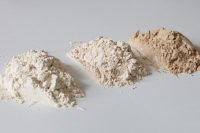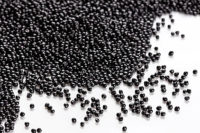
Heavy, abrasive aggregates (foreground) will be added from self-dumping hoppers to the Munson HD-48-SS ribbon blender (background).

An air purge seal between the shaft and the blender wall drives abrasive particles away from the seal, preventing premature wear and leakage.
Master Wall founder and president Steve Smithwick says the company’s Aggre-flex EIFS system is “one of the most common commercial claddings in the country.” Also termed “synthetic stucco,” it consists of a water barrier, adhesive, insulation, mesh, base coat and Master Wall® Superior Finishes topcoat layered with a trowel. Similarly, Master Wall’s Superior Finishes over Stucco systems consist of a water barrier, a base coat and Superior Finishes topcoat. Superior Finishes over Stucco enhances building exteriors with custom colors and textures ranging from fine and coarse sand to an Aggre-Flex Superior Stone Finish that resembles cut stone.
The topcoats are a challenge to blend and they require a durable, heavy-duty blender, explains Glen Smith, manager of process engineering at Master Wall. The high-density topcoats, up to 100 lb/ft3 (1600 kg/m3), comprise heavy, abrasive aggregates of sand and marble blended with pigments in an acrylic polymer binder. The material caused the shaft seals of Master Wall’s blenders to wear and leak.

Bags of pigment and fillers are added through the blender's safety grate.
A Succession of Blenders
Master Wall’s original mixer was a small two-speed propeller-type blade unit placed on top of a 30-gal (114 liter) stainless steel pot, which produced only three 5-gal (19 liter) pails of stucco per batch. Master Wall soon acquired a 150-gal (568 liter) ribbon blender, and over the next 13 years added two more ribbon blenders (450 gal/1703 liter and 900 gal/3407 liter) to the Lithonia, GA, plant. The ribbon blenders combine the ingredients to produce the water barriers, base coats and Superior Finishes topcoats. Today, the plant produces thousands of 5-gal pails of products in one shift.In 2006, Master Wall opened a plant in Payson, UT, to better supply the western U.S. The company specified a Munson HD-48-SS ribbon blender with a 750-gal (2839 liter) capacity (equivalent to 150 5-gal pails per batch) to handle the heavy-duty mixing jobs.

The tight clearance between the ribbon blades and blender trough minimizes residual material after discharge.
Heavy-Duty Task
When blending the coatings in the new 100 ft3 (2.8 m3) ribbon blender, ingredients are added in several steps. First, liquid acrylic polymer and water are metered by a pumping system. While the blender is running, 50-lb (23 kg) bags of pigments and fillers, together with various pre-weighed chemicals, are manually dumped into the blender. Next, pre-weighed aggregates are added from self-dumping hoppers using a forklift. Typically, the blend contains about 25% liquids and 75% solids.The blender runs at full speed for the entire batch mix time, which is usually about 1 hour. Once mixing is complete, a sample is taken for quality control. An operator measures viscosity and pH, and visually compares the sample to a control. When the batch is approved, material is discharged through a manual butterfly valve into 5-gal pails, which are then palletized for shipping.
The 1/16-1/32 in. (1.6-0.8 mm) clearance between the ribbon blades and blender trough minimizes residual material after discharge. “The Munson blender blades sweep closer to the wall than our other blenders, resulting in less waste,” says Smith. Cleaning between batches is not usually needed (production is scheduled so that products with increasingly larger aggregates follow those with smaller aggregates); the blender is simply washed out at the end of the day. While batch sizes vary, the largest batch size is 750 gal (2839 liters)-about 10,000 lbs (453 kg) of material- using the blender’s full working capacity.
The blender’s double helical ribbon agitator design is energy efficient and offers faster blend times than other ribbon configurations. “With our other blenders, we sometimes have to go longer than the desired time to fully homogenize the powders, but with the Munson we can sometimes mix in less than the set time due to the 2-to-1 length-to-width ratio of the double helical ribbon agitator,” says Smith, noting that the 40 hp (30 kw) motor maintains consistent speed when heavy materials are added.
The blender withstands non-stop, all-day mixing of abrasive material without premature seal leakage. In ribbon blenders, packing glands create a mechanical seal where the shaft penetrates the blender wall. The abrasive material in Master Wall’s blends was wearing away the braided Teflon® packing of the blenders in the Georgia plant. This allowed material leaks and required the replacement of the packing (monthly) and eventually the shafts, which required two to three days of downtime. To prevent the problem, the new blender is equipped with air-purge shaft seals that apply positive pressure to drive abrasive particulates away from the seals, which show no signs of wear or leakage two years after installation.

Heavy-duty blended topcoats, typically comprising 75% solids, are discharged into 5-gal pails.
Improved Operator Safety
Master Wall specified four safety grates that cover the top of the ribbon blender, along with trip “kill switches” if the grates are moved. The safety grates and switches are integrated into the machine with a flush-mount sensor. Master Wall also specified lids with dust collection ports on the back half of the blender top that rest on heavy-duty stops when open. Negative pressure dust collectors pull dust out of the blender into a bag house, so little dust escapes into the work area despite the quantities of dusty material being used.Low noise levels are another plus for operator safety. The chain that transfers power from the helical gear motor to the blender’s agitator sprocket runs through an oil bath, thus reducing noise.
Specific Needs
In planning the construction of the Payson plant, Munson representative Bob Jeremias of TEC Engineering helped engineer the blender and dust collection system while Steve Knauth of Munson configured a model to meet Master Wall’s needs. “We needed a durable machine,” says Smith. “Just looking at the blender you can tell it’s a heavy-duty machine because of its sturdy construction.”The company plans to purchase the same brand of ribbon blenders for its Georgia plant.
For more information, contact Munson Machinery Co., Inc. at (315) 797-0090, info@munsonmachinery.com or www.munsonmachinery.com.

